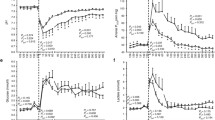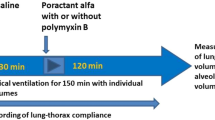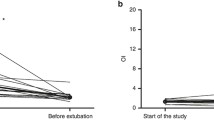Summary
Respiratory distress syndrome (RDS) is characterized by quantitative and qualitative disturbances of surface active substances (surfactant). Therefore, intratracheal surfactant substitution is a favored subject of clinical investigations. In our study we tried to inflate and stabilize lungs in two steps: first, lungs were rinsed with a fluorocarbon and, second, artificially ventilated with a dipalmitoylphosphatidylcholine (DPPC) aerosol, the mean component of surfactant. Sixteen isolated fetal minipig lungs of day 95 (85% of the total gestation period) were used. From one pair of lungs one lung served as control (group 1), whereas the other was treated with DPPC (group II). In both groups the lungs were rinsed first with a fluorocarbon (FC-72, surface tension 12 mN/m). This maneuver was followed by an artificial ventilation with an aerosol of either salt solution (group I) or DPPC (group II) for 40 min. To characterize lung mechanics, static pressure volume curves were registered at 0, 20, and 40 min after fluorocarbon lavage. Airway opening pressure (pi), end-inspiratory volume (vi), and weightspecific end-inspiratory lung compliance (ci) were investigated. As biochemical parameters of the lungs we determined phospholipidphosphate content and DPPC, sphingomyelin (SM), and lysophosphaditylcholine (LPC) of the lung tissue. Significant differences were found with regard to phospholipidphosphate and DPPC content. No difference was seen in static pressure volume diagrams at the end of the investigation period.
Similar content being viewed by others
References
Bangham AD (1987) Lung surfactant — How it does and does not work. Lung 165:17–26
Chapman D, Williams RM, Ladbrooke BD (1967) Physical studies of phospholipids. VI. Thermotropic and lyotropic mesomorphism of some 1,2-diacylphosphatidylcholins (lecithins). Chem Phys Lipids 1:445–475
Chu J, Clements JA, Cotton EK, Klaus MH, Sweet AY, Tooley WH (1967) Neonatal pulmonary ischemia. Pediatrics 49:709–782
Folch J, Lees M, Sloane-Stanley GH (1957) A simple method for the isolation and purification of total lipides from animal tissues. J Biol Chem 226:497–509
Geiger K, Gallagher M, Hedley-Whyte J (1975) Cellular distribution and clearance of aerosolized dipalmitoyllecithin. J Appl Physiol 39:759–766
Groniowski J (1983) Fine structural basis of pulmonary surfactant. Int Rev Exp Pathol 25:184–238
Ivey HH, Roth S, Kattwinkel J (1976) Use of nebulised surfactants in the treatment of the respiratory distress syndrome of infancy. Pediatr Res 10:462
Kraus R, Wuthe J, Rüfer R (1987) Method for determination of different phospholipids by circular high-performance thin-layer chromatography. J Chromatogr Biomed Appl 413:257–263
Martin JB, Doty DM (1949) Determination of inorganic phosphate: Modification of isobutyl alcohol procedure. Anal Chem 21:965–967
Notter RH, Shapiro DL (1981) Lung surfactant in an era of replacement. Ther Pediatr 68:781–789
Notter RH, Finkelstein JN, Taubold RD (1983) Comparative adsorption of natural lung surfactant, extracted phospholipids, and artificial phospholipid mixtures to the air-water inface. Chem Phys Lipids 33:67–80
Obladen M, Popp D, Schöll Ch, Schwarz H, Jähnig F (1983) Studies of lung surfactant replacement in respiratory distress syndrome rapid film formation from binary mixed liposomes. Biochem Biophys Acta 735:215–224
Robillard E, Alaire Y, Dagenais-Perusse P, Baril E, Guilebault A (1964) Microaerosol administration of synthetic — dipalmitoyll-lecithin in the respiratory Distress Syndrome: A preliminary report. Can Med Assoc J 90:55–57
Rüfer R (1967) Der Einfluß oberflächenaktiver Substanzen auf Entfaltung und Retraktion isolierter Lungen. Pflugers Arch 298:170–184
Rüfer R (1968) The influence of surface-active substances on alveolar mechanics in the respiratory distress syndrome. Respiratory 25:441–457
Rüfer R (1970) Surfactant and alveolar surface forces after breathing of an inert fluorinated liquid. Fed Proc 29:1813–1815
Rüfer R, Spitzer HL (1973) Liquid ventilation in the respiratory distress syndrome. 16th Aspen Emphysema Conference [Abstr] 34:73–74
Schannon DC, Kazemi H, Merrill EW, Smith KA, Wong PS (1969) Restoration of volumepressure curves with a lecithin fog. J Appl Physiol 28:470–473
Schürch S, Goerke J, Clements JA (1976) Direct determination of surface tension in the lung. Proc Natl Acad Sci USA 73:4689–4702
Author information
Authors and Affiliations
Additional information
Supported by the Schutzkommission beim Bundesminister des Inneren
Rights and permissions
About this article
Cite this article
Wuthe, J., Förster, W., Dangel, P. et al. Mechanical properties of fetal minipig lungs after substitution of surfactant with fluorocarbon and dipalmitoylphosphatidylcholine. Res. Exp. Med. 188, 247–253 (1988). https://doi.org/10.1007/BF01852273
Received:
Accepted:
Issue Date:
DOI: https://doi.org/10.1007/BF01852273




